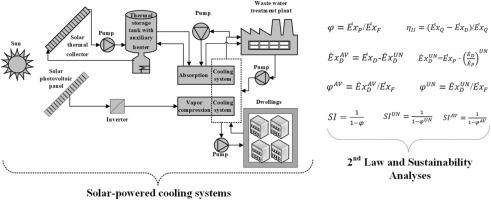当前位置:
X-MOL 学术
›
Process Saf. Environ. Prot.
›
论文详情
Our official English website, www.x-mol.net, welcomes your feedback! (Note: you will need to create a separate account there.)
A numerical approach to exergy-based sustainability and environmental assessments of solar energy-powered district cooling systems using actual operational data
Process Safety and Environmental Protection ( IF 6.9 ) Pub Date : 2024-06-12 , DOI: 10.1016/j.psep.2024.06.043 Huseyin Gunhan Ozcan , Arif Hepbasli , Aysegul Abusoglu
Process Safety and Environmental Protection ( IF 6.9 ) Pub Date : 2024-06-12 , DOI: 10.1016/j.psep.2024.06.043 Huseyin Gunhan Ozcan , Arif Hepbasli , Aysegul Abusoglu

|
The demand for cooling in buildings has been increasing at a higher rate than heating, and more energy is expected to meet this demand. Solar energy can be vital in fulfilling this energy requirement based on its unique renewable energy features. The solar thermal powered absorption cooling (STAC) and solar electrical assisted vapor compression cooling (SEVC) systems are assessed in this study by conducting the conventional and advanced exergy analyses and environmental assessment. Determining the unavoidable part of exergy destruction, as in this study, provides a unique convenience in design problems where the thermodynamic performances of distinct systems are compared. Under current technological conditions, removing the thermodynamically optimized parameters of the designed systems from the minima-maxima dichotomy and rationally evaluating the avoidable part of exergy destruction will protect the researcher from the arbitrariness of the design. The obtained results based on conventional exergy analysis in a component manner showed that priority should be given to solar technologies due to their lowest exergy efficiencies (0.16 for a photovoltaic (PV) and 0.19 for a collector) and sustainability indices (1.20 for the PV and 1.24 for the collector). Advanced exergy analysis results revealed that the exergy destruction significantly originated from the unavoidable part of the total exergy destruction of the components for the solar technologies (93.02 % for the collector and 96.41 % for the PV), cooling (92.12 % for the absorption and 98.42 % for the vapor compression), and overall system (99.92 % for the SEVC and 99.99 % for the STAC). The initial estimated carbon dioxide emissions from the STAC were 0.28 kg CO, attributed to pump power consumption. However, these emissions varied dynamically for the SEVC, ranging from 0 (when the solar PV field meets the total power) to 5.58 kg CO (when radiation is not available), depending on the power-consuming components (compressor and pumps).
中文翻译:

使用实际运行数据对太阳能区域供冷系统进行基于火用的可持续性和环境评估的数值方法
建筑物制冷需求的增长速度高于供暖需求,预计需要更多能源来满足这一需求。由于其独特的可再生能源特性,太阳能对于满足这一能源需求至关重要。本研究通过进行传统和先进的火用分析和环境评估来评估太阳能热动力吸收冷却(STAC)和太阳能电辅助蒸汽压缩冷却(SEVC)系统。正如本研究中那样,确定火用破坏的不可避免的部分,为比较不同系统的热力学性能的设计问题提供了独特的便利。在当前技术条件下,从最小-最大二分法中去除所设计系统的热力学优化参数并合理评估火用破坏的可避免部分将保护研究人员免受设计的随意性影响。基于传统火用分析的组件方式获得的结果表明,应优先考虑太阳能技术,因为其火用效率最低(光伏(PV)为 0.16,集热器为 0.19)和可持续性指数(光伏和集热器为 1.20)。 1.24 对于收集器)。先进的㶲分析结果显示,㶲破坏主要源自太阳能技术组件总㶲破坏中不可避免的部分(集热器为93.02%,PV为96.41%)、冷却(吸收为92.12%,光伏组件为98.42%)。 %(蒸汽压缩)和整个系统(SEVC 为 99.92%,STAC 为 99.99%)。 STAC 的初步估计二氧化碳排放量为 0.28 千克 CO,归因于泵的功耗。 然而,SEVC 的这些排放量动态变化,范围从 0(当太阳能光伏发电场满足总功率时)到 5.58kg CO(当没有辐射时),具体取决于耗电组件(压缩机和泵)。
更新日期:2024-06-12
中文翻译:

使用实际运行数据对太阳能区域供冷系统进行基于火用的可持续性和环境评估的数值方法
建筑物制冷需求的增长速度高于供暖需求,预计需要更多能源来满足这一需求。由于其独特的可再生能源特性,太阳能对于满足这一能源需求至关重要。本研究通过进行传统和先进的火用分析和环境评估来评估太阳能热动力吸收冷却(STAC)和太阳能电辅助蒸汽压缩冷却(SEVC)系统。正如本研究中那样,确定火用破坏的不可避免的部分,为比较不同系统的热力学性能的设计问题提供了独特的便利。在当前技术条件下,从最小-最大二分法中去除所设计系统的热力学优化参数并合理评估火用破坏的可避免部分将保护研究人员免受设计的随意性影响。基于传统火用分析的组件方式获得的结果表明,应优先考虑太阳能技术,因为其火用效率最低(光伏(PV)为 0.16,集热器为 0.19)和可持续性指数(光伏和集热器为 1.20)。 1.24 对于收集器)。先进的㶲分析结果显示,㶲破坏主要源自太阳能技术组件总㶲破坏中不可避免的部分(集热器为93.02%,PV为96.41%)、冷却(吸收为92.12%,光伏组件为98.42%)。 %(蒸汽压缩)和整个系统(SEVC 为 99.92%,STAC 为 99.99%)。 STAC 的初步估计二氧化碳排放量为 0.28 千克 CO,归因于泵的功耗。 然而,SEVC 的这些排放量动态变化,范围从 0(当太阳能光伏发电场满足总功率时)到 5.58kg CO(当没有辐射时),具体取决于耗电组件(压缩机和泵)。











































 京公网安备 11010802027423号
京公网安备 11010802027423号